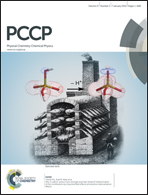A mechanistic investigation of morphology evolution in P3HT–PCBM films induced by liquid crystalline molecules under external electric field†
Abstract
We demonstrate that the morphology of poly(3-hexyl thiophene) and [6,6]-phenyl-C61-butyric acid methyl ester (P3HT–PCBM) bulk heterojunctions (BHJ) could be tuned by the 4-cyano-4′-pentylterphenyl (5CT) liquid crystalline molecules under electric field assisted treatment for enhanced solar cell performance. The miscibility and interactions between the components were carefully studied, showing that 5CT could induce the crystallization of P3HT to form edge-on structures in ternary blends after electric field assisted treatment as revealed by grazing-incidence wide-angle X-ray diffraction (GIXRD). The PCBM and 5CT are supposed to form the rod-like complexes, and the nanorods could orient to the direction of electric field, accompanied by the homogeneous distribution of nanorods in diameters of about 30 nm at an electric field of 600 V mm−1. The sizes of PCBM clusters and complexes are dependent on the 5CT doping ratios and intensity of electric field according to grazing-incidence small-angle X-ray scattering (GISAXS) analysis. When the active layers were processed under the atmospheric environment, the power conversion efficiency (PCE) could reach 3.5% at 5CT weight fraction of 6 wt% after treatment by an electric field of 600 V mm−1, in contrast to the PCE value of 2.4% for a pristine P3HT–PCBM blend. This work provides an attractive strategy for manipulating the nanostructure of BHJ layers and also increases insight into morphology evolution when liquid crystalline molecules are incorporated into BHJs.


 Please wait while we load your content...
Please wait while we load your content...